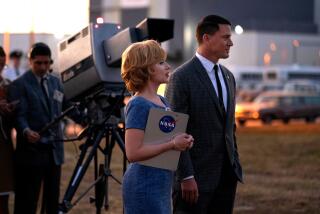FILM REVIEW : Fleet Theater Film Is Mostly Full of Hot Air
- Share via
As much as anyone, the people at the Reuben H. Fleet Space Theater must have been overjoyed to see the recent end to the legal tangles surrounding the America’s Cup. Their latest IMAX offering is “Race the Wind,” an ode to sailing spotlighting the America’s Cup competition, among other forms.
Unfortunately for the Space Theater, the same America’s Cup that makes this film so timely is also its weak link. The 1988 Snooze in the Bay between the Stars and Stripes catamaran and the New Zealand “big boat” is treated as a dramatic encounter, the epitome of modern sailing, which says a lot about the film.
This is easily the most uninspiring production the Space Theater has offered in recent memory. Unlike many of the large-screen IMAX films, “Race the Wind,” which opens an extended run at the Space Theater tonight, lacks any real compelling emotional element. It is a hodgepodge look at attempts to harness wind, from Clipper ships to land yachts, providing only brief glimpses at footage and subjects that may be interesting, but never lingering long enough to actually involve the viewer.
Veteran sailor Tristan Jones, who sails around the world writing books about his travels, provides the film with its narrative thread. He talks about the love of sailing, as he fights the ocean waves alone in his boat.
Though Jones provides a backdrop, a sense of generations fighting the elements, “Race the Wind” goes nowhere. It is visually stimulating at times, featuring gratuitous scenes of water crashing against rocks and rough seas, but there is nothing in the content to stir an audience. Even sailors will be disappointed by the lack of focus.
Filming for “Race the Wind” started in 1987 during the America’s Cup competition off Australia. The ’87 race may have provided some moving footage, but the film only briefly looks at the Australian competition before moving on. Perhaps the show’s producers felt the Australian competition was dated, but in the past the IMAX filmmakers have focused more on quality than timeliness.
Instead, the film spends an inordinate amount of time examing the 1988 fiasco off San Diego. A press release refers to the “excitement and competitive energy” of the San Diego America’s Cup race, which is laughable.
Equally hilarious is a scene in the film showing Dennis Connor playing gracious winner at a press conference, when everyone who followed the race knows he spent most of the time acting boorish and unsportsmanlike, using the press conferences to attack his opponent.
After a recent screening, producer Greg MacGillivray, who found compelling matter with last year’s “To the Limit,” said the Japanese sponsors of “Race the Wind” wanted the film to focus on different aspects of sailing, not just competition, which may explain the unfocused effort.
There are looks at everything from windsurfing to “rollerblading,” a new form of windsurfing on sand, and reports on technology and advances in sailing, but no real sense of human achievement or struggle--elements often found in the best IMAX films.
Although much of the footage is interesting to watch, especially the aerial shots, there is not enough of it to carry the film, which seems to rely more on narration than past IMAX films.
The efforts to invoke images of the glamorous days of sailing and to tie all the elements together by talking about the generational links between sailors, comparing modern day windsurfers to the likes of Magellan and Columbus, comes across like an afterthought, an artificial attempt to give the film an emotional spine.
Far more interesting is the 10-minute fictional short, “Wind From the Sun,” which precedes “Race the Wind.” Taken from an Arthur C. Clarke short story, it is a whimsical look at a futuristic solar sail race from the Earth to the moon, narrated by Dick Enberg.
It’s fun and educational, while telling a story, which means it succeeds on levels “Race the Wind” can only hope to approach.
More to Read
Only good movies
Get the Indie Focus newsletter, Mark Olsen's weekly guide to the world of cinema.
You may occasionally receive promotional content from the Los Angeles Times.










